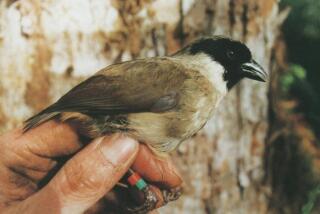They Live, Knock on Wood
- Share via
It’s not every day that an extinct species comes to life, so bird enthusiasts were understandably aflutter last week when Science magazine led its issue with a report of multiple sightings of the ivory-billed woodpecker, a 20-inch-tall bird with a 30-inch wingspan whose demise had been assumed because it hadn’t been definitively spotted since 1944.
The prominence of the report surprised even some ornithologists and taxonomists (classifiers of species), many of whom worry that their own fields are on the verge of extinction, given the diversion since the mid-1990s of taxpayer dollars from “old-fashioned” fieldwork to more technologically elaborate fields like bioengineering.
The question of whether the black- and red-crested birds are alive or dead can seem insignificant when compared with the environmental calamity that a recent United Nations report urges us to confront. One-fifth of the world’s coral reefs and a third of its mangrove forests have been destroyed in recent decades, the report concludes, leaving a third of all animal and plant species at some risk of extinction.
The very grimness of the U.N. report is what makes the woodpecker’s hopeful story so compelling. Jerome A. Jackson, a biologist who has spent 30 years studying the woodpecker, credits national parks and wildlife refuges added since the 1940s for restoring at least a part of the bird’s original Southern forest habitat.
The bird’s apparent survival provides at least a suggestion that the doomsayers aren’t always right.
More to Read
Sign up for Essential California
The most important California stories and recommendations in your inbox every morning.
You may occasionally receive promotional content from the Los Angeles Times.













